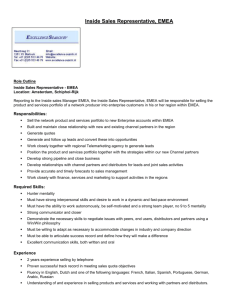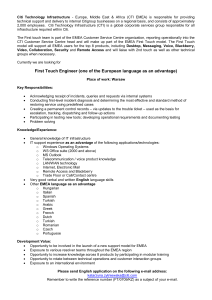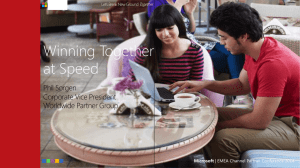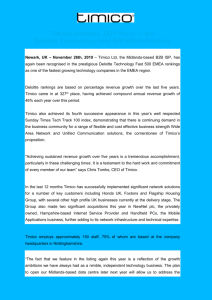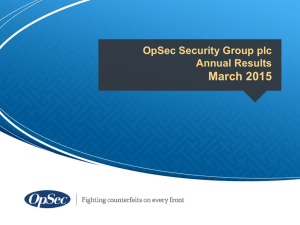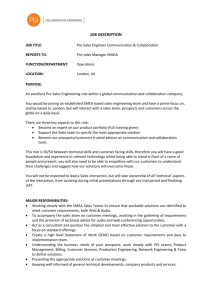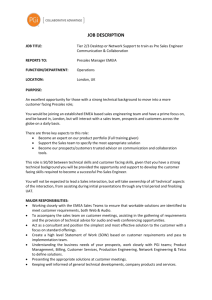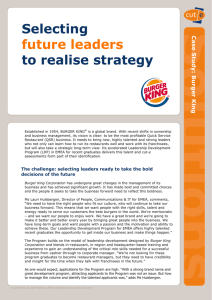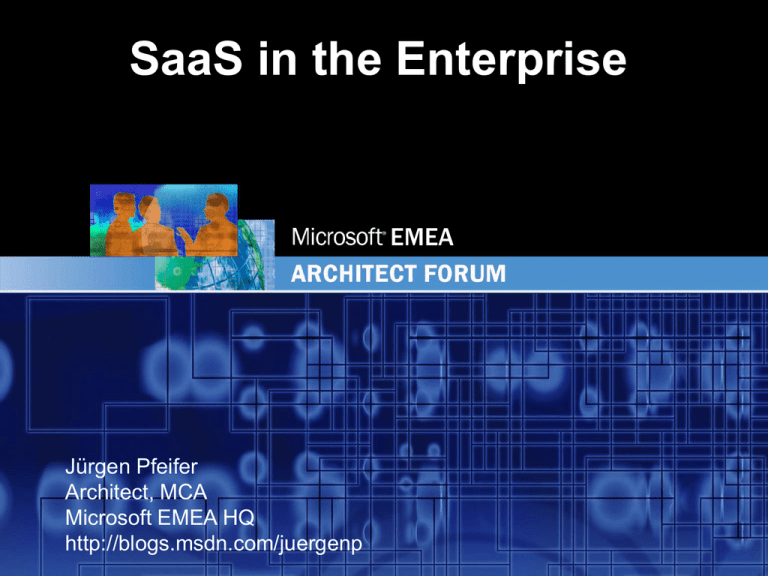
SaaS in the Enterprise
EMEA
Jürgen Pfeifer
Architect, MCA
Microsoft EMEA HQ
http://blogs.msdn.com/juergenp
WHY SAAS: LANDSCAPE AND
VALUE PROPOSITION TO THE
ENTERPRISE
EMEA
Context: “SaaS ecosystem”
EMEA
SaaS Impacts the Entire Consumption Cycle
:
In particular in the L.O.B. application space
Enterprise
Purchase
Deployment
From:
Long Eval Process
From:
Customization
To:
Try before you buy
To:
Configuration
Management
From:
Reliance on internal IT
To:
SLAs
EMEA
Value Prop
Economy
of scale
Hardware Cost
at Provider
People Cost
at Provider
EMEA
But, it‘s not only about consumption
In certain enterprise scenarios becoming a
SaaS provider is an option
Services to Franchisers
Services to a Dealer network
…
EMEA
PRACTICAL
CONSIDERATIONS
EMEA
On Premise or in the “Cloud” ?
TECHNICAL
LEGAL
POLITICAL
FINANCIAL
EMEA
Examples of considerations
Examples
T
F
L P
Boss said so
x
Data security
x
x
Regulatory requirements
x
x
Required features/solution not available out there
x
Business differentiator/core assets
Requires deep integration with in house systems
x
x
No incentive to optimize – what’s the ROI to migrate?
Unique SLA requirements
Availability of credible SaaS providers
x
x
x
x
EMEA
Identity management
Need to cater for multi-tiered authentication and
authorisation models
Each client needs administrators / “super users” and regular users
Integration with enterprise identity management systems
Need to provide single sign-on from within the enterprise to SaaS
application(s)
Extend user provisioning process from enterprise into SaaS domains
Access to audit logs generated by SaaS application(s)
Consolidated reporting for compliance, etc
EMEA
Management integration
A chain is only as strong as its weakest link!
But in a world of SaaS what you care about is much broader
than what you can control directly
Need to be able to gain insight into operational health and
performance of SaaS applications
Benchmark against SLAs
Need to be able to integrate own systems management
information with information emitted from SaaS providers
What happens if your systems management environment uncovers a
problem with the SaaS system? Integration needs to be two-way
EMEA
Data ownership
Cultural issues
Concern about and fear of loss of control
Compliance / Security
Legal/regulatory issues e.g. data privacy limit options to host data
externally or impose additional constraints e.g. testing using live data
Need to extend risk management and security strategies to the SaaS
provider
Compliance demands end-to-end controls – but one end may be in
the SaaS provider
Backup/recovery, disaster recovery
Data protection approaches must extend to externally hosted data
Disaster recovery must incorporate the SaaS solution e.g. can a
disaster recovery site still connect? Is the data accessible?
EMEA
Now that you’ve decided on SaaS
Not all CRM SaaS are created equal.
Due diligence check list:
Data security standards
SLA guarantees – also check what action is promised
when SLA is violated.
Provider migration strategy: Availability of data and code
escrow services
Compliance with vertical regulations
In house integration requirements
Composition features: Web services interfaces
Additional reporting services on hosted data (to support
ongoing BI activities)
EMEA
IMPACT ON YOUR
ARCHITECTURE
EMEA
Integration
EMEA
Composition
EMEA
Office Business Application Services
Critical mass as a solutions platform
Build people ready applications
Use clients and servers create end-user applications
Custom Ribbon and task panes
Open XML file formats for file manipulation
Web part framework integrated with ASP.NET 2.0
Unify your business platform
Single infrastructure for UC&C, ECM, BI
Extensible workflow based on Workflow Foundation
Business Data Catalog for data integration
Extensible search across content types and repositories
More agile development
Reusable client & server components
Single framework for all types of web sites
Tools for all types of developers
EMEA
The 2007 Microsoft Office System
Critical Mass as a Solutions Platform
Office
Business
Applications
Dynamics
Duet
Unified Communication &
Collaboration
ISV OBAs
Business Intelligence
Custom OBAs
Content Management
2007 Office system clients
Extensible User Interface
Workflow
Business Data Catalog
Office
Communications
Server 2007
Search
Tools
Office SharePoint Server 2007
SharePoint Designer
Visual Stuidio Tools for Office
Open XML File Formats
Exchange Server
2007
Microsoft
Office
System
Website & Security Framework
LOB Apps,
data
warehouse,
trading
partners, etc
18
BizTalk Adaptors
Web
Services / BizTalk Adaptor Packs
XML Web services
EMEA
Dynamics
SAP
Siebel
LOB
Extending Enterprise SOA
Off-premise services
Integration +
Composition Platform
Cloud
Edge
Internal
On Premise Services
EMEA
The role of the „EDGE“
SaaS is just one new way to use the „WEB as
a place“
Your WEB functions need to meet future
expectations of your customers,partners and
employees
The „Web 2.0“ wave
Your internal users expect that their own IT
enables this new world of work
e.g. User provided content, Rich Content,
Discovery (Search), Collaboration
EMEA
Users & Experiences
The center of gravity shifts back to the User
It is the age of access
The experience economy
Wisdom of crowds
Democratization, of innovation, of content,
community and commerce
EMEA
Next wave of „Consumerization“
Why not using consumer grade WEB
applications in the enterprise?
Email
Search
Be carefull: One size does not fit all
requirements
E.g. Email records for compliancy
Deep LOB integration necessary to do the job
Complex internal rights management
EMEA
Differentiate IT
Functionality has precedence over
deployment model
Find the right mix for your organisation
EMEA
Drivers
Business
Social
Technical
Technological
EMEA
24
Business Drivers
Changing business models (“Long-tail”)
Monetization
Free / indirect / bundling
Ad based revenue
Transaction based pricing
Subscription
Mini / micro transactions
Long tail
Business aggregation
Consumer to enterprise movement
EMEA
Social Drivers
Changing social models (“Gen U”)
User generated content
Power of numbers
Search and discovery
Community
“Folksonomies”
Personalization and responsiveness
Rich content (voice / image / video)
Ranking / rating
EMEA
Technical Drivers
Software + Services (“Live” era)
High levels of bandwidth and connectivity
Edge power (phone, ipod, PC)
Peer to peer
Mesh networks
Instant deployment / permanent beta
Rich content support (ipod, MP4, VOIP)
Lightweight tools
Channel filtering and aggregation
Application aggregation (mashups)
Services based
EMEA
Technologies
Lightweight technologies
REST
AJAX / Atlas
RSS
ROR
Wikis
IM / Bots
EMEA
EDGE Definition
Provider and consumer model
Provider edge: Enterprises / SOA
Consumer edge: Consumers / Web 2.0
Is Web 2.0 the global SOA?
No they are two Edges
We need an architecture which covers both
EMEA
EDGE Characteristics
Consumer Edge Enterprise Edge
Name
P2P/Web 2.0
SOA/ESB
Control
Decentralized
Centralized
Organization
Unmanaged
Managed
No of types of devices Very Large
Small (servers)
No of devices
Very Large
Large
Connectivity
In the web 2.0 cloud
Medium
Total Power
Huge
Large
Total Demand
Huge
Large
Communication
Async. / REST
Async. / SOAP
Rate of change
Fast
Slow
EMEA
EDGE Common Capabilities
Relationship management
Rich content
Collaboration
Discovery
EMEA
EDGE Architecture
Web 2.0
Relationship
Management
Rich
Content
Collaboration
Discovery
SOA
EMEA
EDGE Architecture
Web 2.0
Relationship
Management
Identity management
Friends, Family, Group management
Access management
Personalization
Tribes and “Folksonomies”
SOA
EMEA
EDGE Architecture
Web 2.0
Rich
Content
Video
TV
Image
Audio
Geo
Movie
SOA
EMEA
EDGE Architecture
Web 2.0
Blogs
Wikis
IM
Email
Discussion
boards
Collaboration
Conferencing
(audio, video)
Back
channeling
Bots
Wikipedia
SOA
EMEA
EDGE Architecture
Web 2.0
Search
Tagging
Ranking and
Discovery
rating
Clouding
SOA
EMEA
EDGE Architecture
Web 2.0
Relationship
Management
Rich
Content
Collaboration
Discovery
SOA
EMEA
EDGE Architecture
Relationship
Management
Interaction/
Composite
Application
Rich
Content
Services/
Messaging
Collaboration
Workflow/
Process
Identity &
Access
Management
Discovery
Federated
Data
EMEA
Patterns on the EDGE
Peer to peer (XBox Live, Napster, Skype)
Centralized (MSN Spaces, Google)
Asynchronous (Fremont, Flickr,
Housingmaps)
Hybrid
…
EMEA
Customers
Relationships
People
Operations
Products/Services
EMEA
Software Architecture at the EDGE
Web 2.0
Put the User back
into SOA
SOA
EMEA
Software Architecture at the EDGE
Web 2.0
User/Experiences
Architecture
SOA
EMEA
© 2006,2007 Microsoft Corporation. All rights reserved.
This presentation is for informational purposes only. MICROSOFT MAKES NO WARRANTIES, EXPRESS OR IMPLIED, IN THIS SUMMARY.

